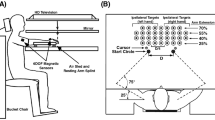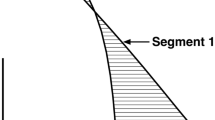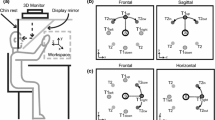Abstract
Speed accuracy trade-off, the inverse relationship between movement speed and task accuracy, is a ubiquitous feature of skilled motor performance. Many previous studies have focused on the dominant arm, unimanual performance in both simple tasks, such as target reaching, and complex tasks, such as overarm throwing. However, while handedness is a prominent feature of human motor performance, the effect of limb dominance on speed-accuracy relationships is not well-understood. Based on previous research, we hypothesize that dominant arm skilled performance should depend on visual information and prior task experience, and that the non-dominant arm should show greater skill when no visual information nor prior task information is available. Forty right-handed young adults reached to 32 randomly presented targets across a virtual reality workspace with either the left or the right arm. Half of the participants received no visual feedback about hand position throughout each reach. Sensory information and task experience were lowest during the first cycle of exposure (32 reaches) in the no-vision condition, in which visual information about motion was not available. Under this condition, we found that the left arm group showed greater skill, measured in terms of position error normalized to speed, and by error variability. However, as task experience and sensory information increased, the right arm group showed substantial improvements in speed-accuracy relations, while the left arm group maintained, but did not improve, speed-accuracy relations throughout the task. These differences in performance between dominant and non-dominant arm groups during the separate stages of the task are consistent with complimentary models of lateralization, which propose different proficiencies of each hemisphere for different features of control. Our results are incompatible with global dominance models of handedness that propose dominant arm advantages under all performance conditions.



Similar content being viewed by others
References
Annett J, Annett M, Hudson PT, Turner A (1979) The control of movement in the preferred and non-preferred hands. Q J Exp Psychol 31:641–652. https://doi.org/10.1080/14640747908400755
Apker GA, Dyson K, Frantz G, Buneo CA (2014) Efficiency of visual feedback integration differs between dominant and non-dominant arms during a reaching task. Exp Brain Res. https://doi.org/10.1007/s00221-014-4116-5
Bagesteiro LB, Sainburg RL (2002) Handedness: dominant arm advantages in control of limb dynamics. J Neurophysiol. https://doi.org/10.1152/jn.00901.2001
Bagesteiro LB, Sainburg RL (2006) Nondominant arm advantages in load compensation during rapid elbow joint movements. J Neurophysiol. https://doi.org/10.1152/jn.00189.2003
Birbaumer N (2007) Motor learning: passing a skill from one hand to the other. Curr Biol
Bortoli L, Robazza C, Durigan V, Carra C (1992) Effects o f contextual interference and age o n acquisition, retention, and transfer. Percept Mot Skills
Boulinguez P, Ferrois M, Graumer G (2003) Hemispheric asymmetry for trajectory perception. Cogn Brain Res. https://doi.org/10.1016/S0926-6410(02)00276-8
Brady F (2004) Contextual interference: a meta-analytic study. Percept Mot Skills. https://doi.org/10.2466/pms.99.1.116-126
Criscimagna-Hemminger SE, Donchin O, Gazzaniga MS, Shadmehr R (2003) Learned dynamics of reaching movements generalize from dominant to nondominant arm. J Neurophysiol. https://doi.org/10.1152/jn.00622.2002
Damm L, McIntyre J (2008) Physiological basis of limb-impedance modulation during free and constrained movements. J Neurophysiol. https://doi.org/10.1152/jn.90471.2008
Dhawale AK, Smith MA, Ölveczky BP (2017) The role of variability in motor learning. Annu Rev Neurosci. https://doi.org/10.1146/annurev-neuro-072116-031548
Duff SV, Sainburg RL (2007) Lateralization of motor adaptation reveals independence in control of trajectory and steady-state position. Exp Brain Res. https://doi.org/10.1007/s00221-006-0811-1
Fink GR, Marshall JC, Halligan PW, Frith CD, Driver J, Frackowiak RSJ, Dolan RJ (1999) The neural consequences of conflict between intention and the senses. Brain 122:497–512. https://doi.org/10.1093/brain/122.3.497
Fitts PM (1954) The information capacity of the human motor system in controlling the amplitude of movement. J Exp Psychol. https://doi.org/10.1037/h0055392
Fitts PM, Peterson JR (1964) Information capacity of discrete motor responses. J Exp Psychol. https://doi.org/10.1037/h0045689
Geisser S, Greenhouse SW (1958) An extension of box’s results on the use of the F distribution in multivariate analysis. Ann Math Stat. https://doi.org/10.1214/aoms/1177706545
Ghez C, Scheidt R, Heijink H (2007) Different learned coordinate frames for planning trajectories and final positions in reaching. J Neurophysiol. https://doi.org/10.1152/jn.00652.2007
Goble DJ, Brown SH (2007) Task-dependent asymmetries in the utilization of proprioceptive feedback for goal-directed movement. Exp Brain Res. https://doi.org/10.1007/s00221-007-0890-7
Goble DJ, Brown SH (2008) Upper limb asymmetries in the matching of proprioceptive versus visual targets. J Neurophysiol. https://doi.org/10.1152/jn.90259.2008
Goble DJ, Brown SH (2010) Upper limb asymmetries in the perception of proprioceptively determined dynamic position sense. J Exp Psychol Hum Percept Perform. https://doi.org/10.1037/a0018392
Goble DJ, Lewis CA, Brown SH (2006) Upper limb asymmetries in the utilization of proprioceptive feedback. Exp Brain Res. https://doi.org/10.1007/s00221-005-0280-y
Green S, Sherwood DE (2000) The benefits of random variable practice for accuracy and temporal error detection in a rapid aiming task. Res Q Exerc Sport. https://doi.org/10.1080/02701367.2000.10608922
Haaland KY, Schaefer SY, Knight RT, Adair J, Magalhaes A, Sadek J, Sainburg RL (2009) Ipsilesional trajectory control is related to contralesional arm paralysis after left hemisphere damage. Exp Brain Res. https://doi.org/10.1007/s00221-009-1836-z
Heitz RP (2014) The speed-accuracy tradeoff: history, physiology, methodology, and behavior. Front Neurosci 8:150
Heitz RP, Schall JD (2012) Neural Mechanisms of Speed-Accuracy Tradeoff. Neuron. https://doi.org/10.1016/j.neuron.2012.08.030
Hull CJ (1936) A study of laterality test items. J Exp Educ 4:287–290
Jackson Barnette J, McLean JE (2005) Type I error of four pairwise mean comparison procedures conducted as protected and unprotected tests. J Mod Appl Stat Methods. https://doi.org/https://doi.org/10.22237/jmasm/1130803740
Jayasinghe SAL, Sarlegna FR, Scheidt RA, Sainburg RL (2020) The neural foundations of handedness: Insights from a rare case of deafferentation. J Neurophysiol. https://doi.org/10.1152/jn.00150.2020
Johnson NL (1949) Systems of frequency curves generated by methods of translation. Biometrika. https://doi.org/10.1093/biomet/36.1-2.149
Krakauer JW, Hadjiosif AM, Xu J, Wong AL, Haith AM (2019) Motor learning. Compr Physiol. https://doi.org/10.1002/cphy.c170043
Liepmann H (1908) Die linke Hemisphäre und das Handeln. In: Drei Aufsätze aus dem Apraxiegebiet. Karger Publishers, pp 17–50
Magill RA, Hall KG (1990) A review of the contextual interference effect in motor skill acquisition. Hum Mov Sci. https://doi.org/10.1016/0167-9457(90)90005-X
Mauchly JW (1940) Significance Test for Sphericity of a Normal n-Variate Distribution. Ann Math Stat. https://doi.org/10.1214/aoms/1177731915
Oldfield RC (1971) The assessment and analysis of handedness: The Edinburgh inventory. Neuropsychologia. https://doi.org/10.1016/0028-3932(71)90067-4
Pauwels L, Swinnen SP, Beets IAM (2014) Contextual interference in complex bimanual skill learning leads to better skill persistence. PLoS ONE. https://doi.org/10.1371/journal.pone.0100906
Pereira EAH, Raja K, Gangavalli R (2011) Effect of training on interlimb transfer of dexterity skills in healthy adults. Am J Phys Med Rehabil. https://doi.org/10.1097/PHM.0b013e3181fc7f6f
Plamondon R, Alimi AM (1997) Speed/accuracy trade-offs in target-directed movements. Behav Brain Sci 20:279–303
Przybyla A, Coelho CJ, Akpinar S, Kirazci S, Sainburg RL (2013) Sensorimotor performance asymmetries predict hand selection. Neuroscience 228:349–360
Roy EA, Roy EA, Elliott D (1989) Manual Asymmetries in Aimed Movements. Q J Exp Psychol Sect A. https://doi.org/10.1080/14640748908402379
Sachlikidis A, Salter C (2007) A biomechanical comparison of dominant and non-dominant arm throws for speed and accuracy. Sport Biomech 6:334–344
Sainburg R (2002) Evidence for a dynamic-dominance hypothesis of handedness. Exp Brain Res. https://doi.org/10.1007/s00221-001-0913-8
Sainburg RL, Kalakanis D (2000) Differences in control of limb dynamics during dominant and nondominant arm reaching. J Neurophysiol. https://doi.org/10.1152/jn.2000.83.5.2661
Sainburg RL, Schaefer SY (2004) Interlimb differences in control of movement extent. J Neurophysiol. https://doi.org/10.1152/jn.00181.2004
Sainburg RL, Wang J (2002) Interlimb transfer of visuomotor rotations: Independence of direction and final position information. Exp Brain Res. https://doi.org/10.1007/s00221-002-1140-7
Schabowsky CN, Hidler JM, Lum PS (2007) Greater reliance on impedance control in the nondominant arm compared with the dominant arm when adapting to a novel dynamic environment. Exp Brain Res. https://doi.org/10.1007/s00221-007-1017-x
Schaefer SY, Haaland KY, Sainburg RL (2007) Ipsilesional motor deficits following stroke reflect hemispheric specializations for movement control. Brain. https://doi.org/10.1093/brain/awm145
Schaefer SY, Haaland KY, Sainburg RL (2009) Hemispheric specialization and functional impact of ipsilesional deficits in movement coordination and accuracy. Neuropsychologia. https://doi.org/10.1016/j.neuropsychologia.2009.06.025
Schaffer JE, Sainburg RL (2017) Bimanual reflexes during shared bimanual tasks are asymmetric. In: Society for Neuroscience Annual Meeting
Scheidt RA, Ghez C (2007) Separate adaptive mechanisms for controlling trajectory and final position in reaching. J Neurophysiol. https://doi.org/10.1152/jn.00121.2007
Schmidt RA, Zelaznik H, Hawkins B, Frank JS, Quinn JT Jr (1979) Motor-output variability: a theory for the accuracy of rapid motor acts. Psychol Rev. https://doi.org/10.1037/0033-295X.86.5.415
Shapiro SS, Wilk MB (1965) An analysis of variance test for normality (complete samples). Biometrika. https://doi.org/10.2307/2333709
Shea JB, Morgan RL (1979) Contextual interference effects on the acquisition, retention, and transfer of a motor skill. J Exp Psychol Hum Learn Mem. https://doi.org/10.1037/0278-7393.5.2.179
Shmuelof L, Krakauer JW, Mazzoni P (2012) How is a motor skill learned? Change and invariance at the levels of task success and trajectory control. J Neurophysiol 108:578–594. https://doi.org/10.1152/jn.00856.2011
Takagi A, Maxwell S, Melendez-Calderon A, Burdet E (2020) The dominant limb preferentially stabilizes posture in a bimanual task with physical coupling. J Neurophysiol. https://doi.org/10.1152/jn.00047.2020
Van Der Vliet R, Frens MA, De Vreede L, Jonker ZD, Ribbers GM, Selles RW, Van Der Geest JN, Donchin O (2018) Individual differences in motor noise and adaptation rate are optimally related. eNeuro. https://doi.org/https://doi.org/10.1523/ENEURO.0170-18.2018
Volkmann J, Schnitzler A, Witte OW, Freund HJ (1998) Handedness and asymmetry of hand representation in human motor cortex. J Neurophysiol. https://doi.org/10.1152/jn.1998.79.4.2149
Wang J, Sainburg RL (2004) Limitations in interlimb transfer of visuomotor rotations. Exp Brain Res. https://doi.org/10.1007/s00221-003-1691-2
Wang J, Sainburg RL (2006) The symmetry of interlimb transfer depends on workspace locations. Exp Brain Res. https://doi.org/10.1007/s00221-005-0230-8
Wang J, Sainburg RL (2007) The dominant and nondominant arms are specialized for stabilizing different features of task performance. Exp Brain Res. https://doi.org/10.1007/s00221-007-0936-x
Woytowicz EJ, Westlake KP, Whitall J, Sainburg RL (2018) Handedness results from complementary hemispheric dominance, not global hemispheric dominance: evidence from mechanically coupled bilateral movements. J Neurophysiol. https://doi.org/10.1152/jn.00878.2017
Wu HG, Miyamoto YR, Castro LNG, Ölveczky BP, Smith MA (2014) Temporal structure of motor variability is dynamically regulated and predicts motor learning ability. Nat Neurosci. https://doi.org/10.1038/nn.3616
Yadav V, Sainburg RL (2011) Motor lateralization is characterized by a serial hybrid control scheme. Neuroscience. https://doi.org/10.1016/j.neuroscience.2011.08.039
Yadav V, Sainburg RL (2014a) Handedness can be explained by a serial hybrid control scheme. Neuroscience. https://doi.org/10.1016/j.neuroscience.2014.08.026
Yadav V, Sainburg RL (2014b) Limb dominance results from asymmetries in predictive and impedance control mechanisms. PLoS ONE. https://doi.org/10.1371/journal.pone.0093892
Yarrow K, Brown P, Krakauer JW (2009) Inside the brain of an elite athlete: The neural processes that support high achievement in sports. Nat. Rev, Neurosci
Zabihhosseinian M, Gilley R, Andrew D, Murphy B, Yielder P (2020) Differential changes in early somatosensory evoked potentials between the dominant and non-dominant hand, following a novel motor tracing task. Brain Sci 10:290
Ziemann U, Hallett M (2001) Hemispheric asymmetry of ipsilateral motor cortex activation during unimanual motor tasks: Further evidence for motor dominance. Clin Neurophysiol. https://doi.org/10.1016/S1388-2457(00)00502-2
Funding
The project described was supported by National Institutes of Health Award Number R01HD059783, along with the National Center for Advancing Translational Sciences, Grant TL1 TR002016 and Grant UL1 TR002014. The content is solely the responsibility of the authors and does not necessarily represent the official views of the NIH.
Author information
Authors and Affiliations
Corresponding author
Ethics declarations
Conflict of interest
The authors declared no potential conflicts of interest with respect to the research, authorship, and/or publication of this article.
Additional information
Communicated by Bill J Yates.
Publisher's Note
Springer Nature remains neutral with regard to jurisdictional claims in published maps and institutional affiliations.
Rights and permissions
About this article
Cite this article
Dexheimer, B., Sainburg, R. When the non-dominant arm dominates: the effects of visual information and task experience on speed-accuracy advantages. Exp Brain Res 239, 655–665 (2021). https://doi.org/10.1007/s00221-020-06011-6
Received:
Accepted:
Published:
Issue Date:
DOI: https://doi.org/10.1007/s00221-020-06011-6




